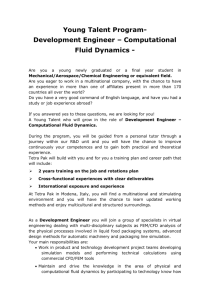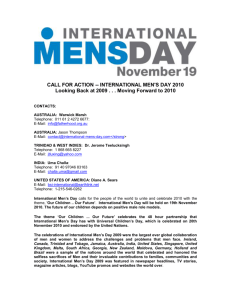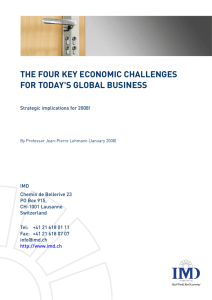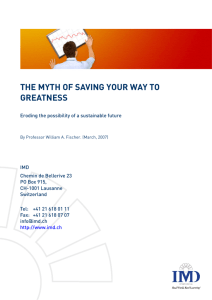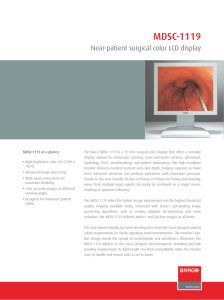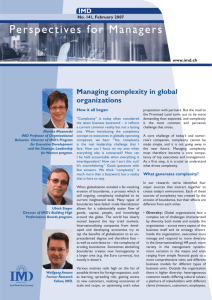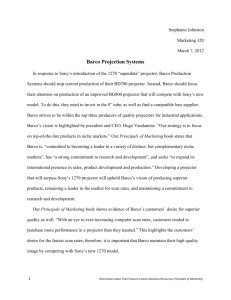Business-to-Business Marketing – WS 2014
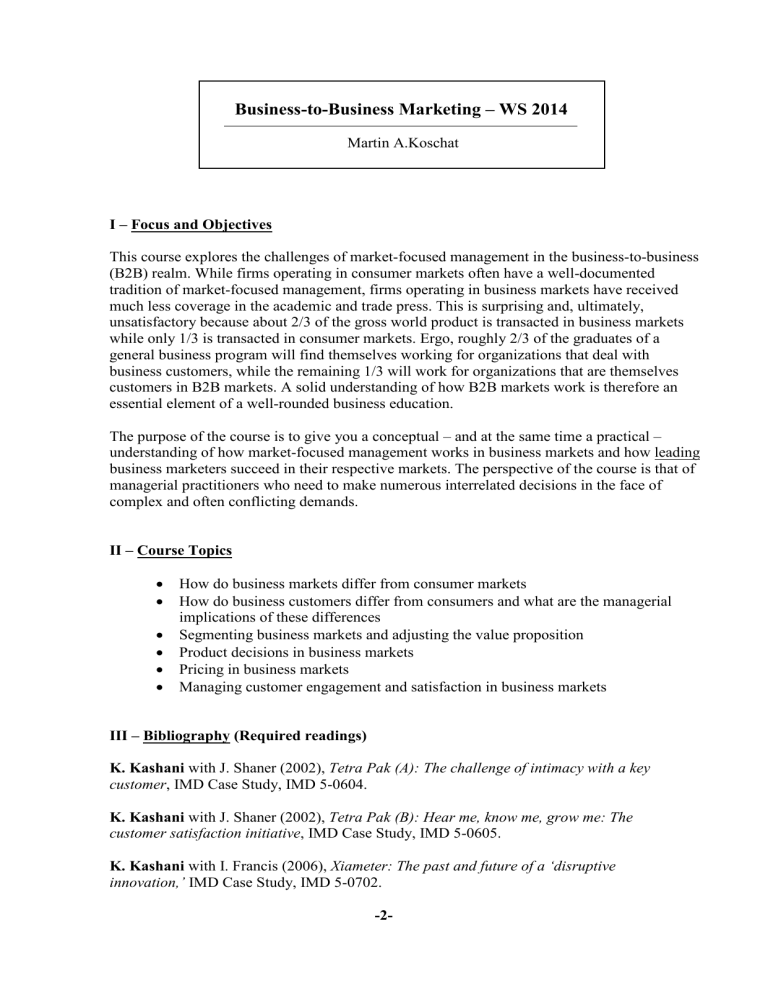
Business-to-Business Marketing – WS 2014
Martin A.Koschat
I – Focus and Objectives
This course explores the challenges of market-focused management in the business-to-business
(B2B) realm. While firms operating in consumer markets often have a well-documented tradition of market-focused management, firms operating in business markets have received much less coverage in the academic and trade press. This is surprising and, ultimately, unsatisfactory because about 2/3 of the gross world product is transacted in business markets while only 1/3 is transacted in consumer markets. Ergo, roughly 2/3 of the graduates of a general business program will find themselves working for organizations that deal with business customers, while the remaining 1/3 will work for organizations that are themselves customers in B2B markets. A solid understanding of how B2B markets work is therefore an essential element of a well-rounded business education.
The purpose of the course is to give you a conceptual – and at the same time a practical – understanding of how market-focused management works in business markets and how leading business marketers succeed in their respective markets. The perspective of the course is that of managerial practitioners who need to make numerous interrelated decisions in the face of complex and often conflicting demands.
II – Course Topics
• How do business markets differ from consumer markets
• How do business customers differ from consumers and what are the managerial implications of these differences
• Segmenting business markets and adjusting the value proposition
• Product decisions in business markets
• Pricing in business markets
• Managing customer engagement and satisfaction in business markets
III – Bibliography (Required readings)
K. Kashani with J. Shaner (2002), Tetra Pak (A): The challenge of intimacy with a key customer , IMD Case Study, IMD 5-0604.
K. Kashani with J. Shaner (2002), Tetra Pak (B): Hear me, know me, grow me: The customer satisfaction initiative , IMD Case Study, IMD 5-0605.
K. Kashani with I. Francis (2006), Xiameter: The past and future of a ‘disruptive innovation,’ IMD Case Study, IMD 5-0702.
-2-
K. Kashani with A. DuBrule (2009), Value selling at SKF Service (A): Tough buyer confronts strategy , IMD Case Study, IMD 5-0751.
G. Narayandas and G. Swartz (2001), Kone: The MONOSPACE launch in Germany ,
HBS Case Study, 9-501-070.
S. Muylle and M. Debruyne (2009), Barco: Leading the Events Market , Vlerick
Business School Case Study, VLGMS-0906-C.
J. Walsh with A. Woolfrey and S. Coughlan (2008), The Coca-Cola Company
(abridged) , IMD Case Study, IMD 5-0741.
IV – Course Work and Methods of Evaluation
The primary method of learning in this course is based on managerially-oriented case discussions . Cases allow you to learn from the experience of managers operating in realworld companies and from immersion in practical management and business decisions.
The cases capture the complexity faced by managers on all levels. The cases that will be assigned represent a diverse spectrum of management issues. They have been selected for their particular relevance to the issues under discussion, as well as for their capacity and track records as good learning vehicles.
Thorough preparation of each case is a prerequisite to learning – there are no short cuts!
It is expected that you individually read and prepare the assigned case studies before coming to class. We will also use small group discussions around specific assignments to further the analysis. However, group discussions are a complement to individual preparation and are not a substitute for it.
Each regular session will start with a short multiple choice quiz that will test your comprehension of the case facts. You will earn positive points for correct answers and negative points for incorrect answers. Hence it requires a fair amount of preparation to obtain an overall positive score. (Please arrive in class on time, as there will be no make-up quizzes later on.)
Equally important to learning is the active involvement and contribution to class discussions. Class participation has multiple benefits. It helps you to sharpen your skills in developing a point of view, articulating this point of view and – in the face of challenges from your fellow students and your instructor – defending your point of view. It also benefits your classmates by sharing your analysis and insights with them.
In your contribution to in-class learning – largely your contributions to case discussions
– your aim should be to move the discussion of a case along and, in doing so, generate new insights for your colleagues. Thus, your contribution should be motivated by the substance of what you have to say rather than by a perceived need to get in airtime. The quality of the contribution matters! You will earn positive points for positive contributions to class and group discussions, and negative points for distracting
-3-
behavior such as unexcused late arrival to class or texting and surfing the Web during class.
Finally, there will also be an in-class, written, final exam administered during the last session of the course. You will be given a case similar to the cases that have been covered during the stream and you will be asked to perform your own case analysis.
You will be evaluated based on your performance on the quizzes (1/3 of the overall grade), in-class contribution (1/3 of the overall grade) and the written final exam (1/3 of the overall grade).
One final reminder: Please note that preparation and class attendance are not optional; they are mandatory . If you cannot attend during the scheduled sessions shown below, this course is not for you. If you cannot attend a given session (as a result of illness or other emergencies), you should let me know in advance either in person or via email at: martin_koschat@hotmail.com
.
V – Course Director
Instructor: Prof. DDr. Martin A. Koschat
email: martin_koschat@hotmail.com
VI – Language of Instruction
Business English
VII – Schedule of Class Sessions
We will begin the course with a short preview session on October 7, 2014, in HS 16 starting at 13:30 and ending before 14:45. I will present a brief overview of the course and you will have the opportunity to ask questions to determine whether this course is for you.
Subsequently, we will have six case discussions which will take place on October 14, October
21, November 4, November 11, November 18, November 25 and December 2. (Note these comprise 7 dates. One of these dates will be cancelled during the semester.) The final exam is an in-class exam and will take place on December 9 during the regular class hours from 11:45 to 14:45. Your participation is essential. Make-up exams will only be administered in case of documented force majeure. You will have the opportunity to review the final exam with me on January 13, from 11:45 to 14:45, if you so choose. (You need to schedule an appointment with me.)
Note : All sessions – with one exception – take place on Tuesdays, on the dates mentioned, from 11:45 (s.t.) to 14:45 in HS 15 . The session on Tuesday, October 14, will take place in
HS 16 , again from 11:45 (s.t.) to 14:45.
-4-
Session 1 : How do business markets differ from consumer markets?
Preparation: Read the case The Coca Cola Company with the following questions in mind:
1.
What are the functions performed by TCCC, its bottlers and retailers in bringing a bottle of Coca-Cola to a consumer?
2.
What is TCCC’s value proposition to its bottlers and the retailers that sell
TCCC’s products?
3.
How and why has TCCC’s approach to its customers changed over the last two decades?
Session 2 : How do business customers differ from consumers and what are the managerial implications of these differences?
Preparation: Read the case KONE: The MonoSpace© Launch in Germany with the following questions in mind:
1.
What can be learned from the test market and market launches in France, the
Netherlands and the UK?
2.
How would you price, promote and distribute MonoSpace©.
3.
What core competencies at KONE will need to be managed to ensure the success of your marketing plan?
4.
What reactions do you expect from competitors and how will you manage these reactions?
Session 3 : Segmenting business markets and adjusting the value proposition
Preparation: Read the case Xiameter: The past and future of a ‘disruptive innovation’ with the following questions in mind:
1.
What factors, internal or external, were responsible for Dow Corning's poor performance between 1995 and 2001?
2.
What did the new segmentation reveal about customers beyond what the company knew already? In what ways was this scheme an improvement over the previous and traditional end-user segmentation?
3.
Trace the development of Xiameter from its beginnings: In your opinion, what were the key decisions that shaped its business and marketing strategies?
4.
Was the "dual-brand strategy" a good idea? If so, why? If not, why not?
-5-
Session 4 : Product decisions in business markets
Preparation: Read the case Barco: Leading the Events Market with the following questions in mind:
1.
What is Barco´s financial position at the time of the case?
2.
How important is it for Barco to introduce a new product?
3.
In which segments does Barco compete and why?
4.
Where does Barco´s most serious competitive threat come from, and how should
Barco deal with it?
Session 5: Pricing in business markets
Preparation: Read the case Value selling at SKF Service (A): Tough buyer confronts strategy with the following questions in mind:
1.
What are the dynamics in SKF’s end-user market?
2.
How do these dynamics affect SKF’s market position?
3.
In the current market environment, how sustainable is SKF’s strategy of not pursuing “price seekers?”
4.
Are reverse auctions a challenge to SKF’s business model?
5.
Should SKF participate in Steelcorp’s reverse auction?
Session 6 : Managing customer engagement and satisfaction in business markets
Preparation: Read the cases Tetra Pak (A): The Challenge of Intimacy with a
Key Customer and Tetra Pak (B): Hear me, know me, grow me: The Customer
Satisfaction Initiative with the following questions in mind:
1.
How serious is Pontero’s problem in his market?
2.
How well did Tetra Pak diagnose Pontero’s problem?
3.
How sensible is Tetra Pak’s proposal to Pontero?
4.
What do you make of the customer satisfaction survey results?

